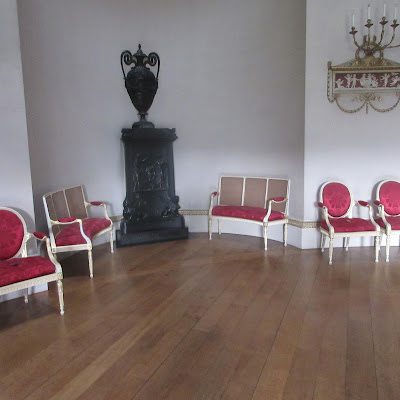The floor in the Marble Hall dates back to the 1760s and its condition is deteriorating. The pillars were originally smooth but I can't remember when they were changed to this format.
I loved the way the decorative plaster was made to hold the paintings.
I would really love one of these 18th century Reading Chairs. It would be so comfortable and so conducive to concentration!
This is an absolutely magnificent desk and in great condition. To the left is a drawer that pulls out the length of the desk which means that the top drawers at the top are fake. I loved it!
In this formal dining room the paintings are all connected to the theme of food.
This was a wonderful exhibit - the dress is 115 years old and it looks fantastic. The first time it was worn was to the Delhi Durbar in 1903 to celebrate the 1902 coronation of King Edward VII. It was worn by Lady Mary Curzon wife of the viceroy Lord Curzon who owned Kedleston Hall.
The emerald like eye of each plume is set with iridescent green beetle wings and the embroidery is gold and silver. It must have been horrendously heavy to wear! The dress was later altered to reflect the change in fashion
We then went for a 2-3km walk in the grounds.
We then visited the Church in the grounds.
We thoroughly enjoyed the visit and then went to Newark to collect Stephen who was working that day in Carol's museum. The heavens opened as we wandered Newark but we managed to get to the car for shelter before we were drenched.
Tomorrow home for a day before our 3 French guests arrive!




























































